The Astor family achieved prominence in business, society, and politics in the United States and the United Kingdom during the 19th and 20th centuries. With Italian German ancestral roots in the Italian and Swiss Alps, the Astors settled in Germany, first appearing in North America in the 18th century with John Jacob Astor, one of the wealthiest people in history.

William Waldorf Astor, 1st Viscount Astor was an American-English attorney, politician, businessman, and philanthropist. Astor was a scion of the very wealthy Astor family of New York City. He moved to England in 1891, became a British subject in 1899, and was made a peer as Baron Astor in 1916 and Viscount Astor in 1917 for his contributions to war charities.

Waldorf Astor, 2nd Viscount Astor, DL was an American-born English politician and newspaper proprietor. He was a member of the Astor family. He was active in minor political roles. He was devoted to charitable projects, and with his more famous wife Nancy became a prominent fixture in upper class English society.
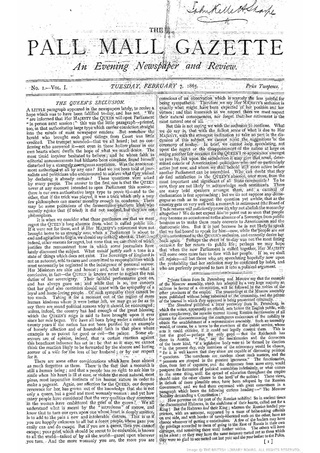
The Pall Mall Gazette was an evening newspaper founded in London on 7 February 1865 by George Murray Smith; its first editor was Frederick Greenwood. In 1921, The Globe merged into The Pall Mall Gazette, which itself was absorbed into The Evening Standard in 1923.
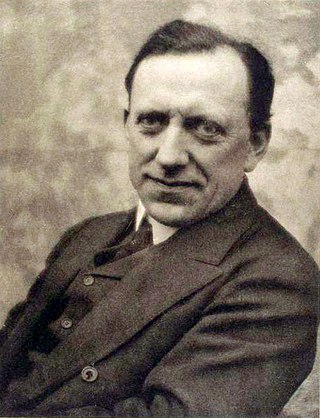
James Louis Garvin was a British journalist, editor, and author. In 1908, Garvin agreed to take over the editorship of the Sunday newspaper The Observer, revolutionising Sunday journalism and restoring the paper, which was facing financial troubles at the time, to profitability in the process.

The Stolen Bacillus and Other Incidents is a collection of fifteen fantasy and science fiction short stories written by the English author H. G. Wells between 1893 and 1895. It was first published by Methuen & Co. in 1895 and was Wells's first book of short stories. All of the stories had first been published in various weekly and monthly periodicals.

Lippincott's Monthly Magazine was a 19th-century literary magazine published in Philadelphia from 1868 to 1915, when it relocated to New York to become McBride's Magazine. It merged with Scribner's Magazine in 1916.

John Coulson Kernahan was an English novelist.
Julian Osgood Field (1852–1925) was an American socialite and writer. Some of his works were published under the pseudonyms X.L. or Sigma.

Edmund Joseph Sullivan (1869–1933), usually known as E. J. Sullivan, was a British book illustrator who worked in a style which merged the British tradition of illustration from the 1860s with aspects of Art Nouveau.

The Studio: An Illustrated Magazine of Fine and Applied Art was an illustrated fine arts and decorative arts magazine published in London from 1893 until 1964. The founder and first editor was Charles Holme. The magazine exerted a major influence on the development of the Art Nouveau and Arts and Crafts movements. It was absorbed into Studio International magazine in 1964.
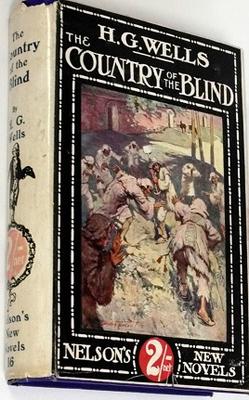
The Country of the Blind and Other Stories is a collection of thirty-three fantasy and science fiction short stories written by the English author H. G. Wells between 1894 and 1909. It was first published by Thomas Nelson and Sons in 1911. All the stories had first been published in various weekly and monthly periodicals. Twenty-seven of the stories had also been previously published in five earlier story collections by Wells.

H. G. Wells was a prolific writer of both fiction and non-fiction. His writing career spanned more than sixty years, and his early science fiction novels earned him the title of "The Father of Science Fiction".
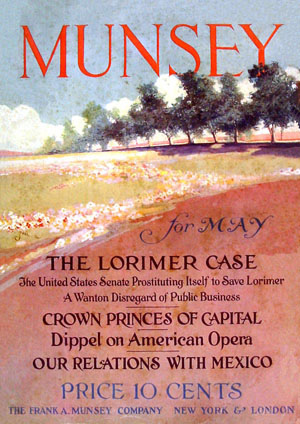
Munsey's Weekly, later known as Munsey's Magazine, was a 36-page quarto American magazine founded by Frank A. Munsey in 1889 and edited by John Kendrick Bangs. Frank Munsey aimed to publish "a magazine of the people and for the people, with pictures and art and good cheer and human interest throughout". Soon after its inception, the magazine was selling 40,000 copies a week. In 1891, Munsey's Weekly adopted a monthly schedule and was renamed Munsey's Magazine.

Cassell's Magazine is a British magazine that was published monthly from 1897 to 1912. It was the successor to Cassell's Illustrated Family Paper, (1853–1867) becoming Cassell's Family Magazine in 1874, Cassell's Magazine in 1897, and, after 1912, Cassell's Magazine of Fiction.
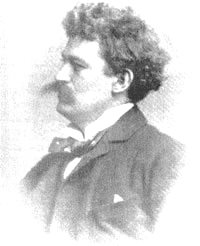
Henry Brereton Marriott Watson, known by his pen name H. B. Marriott Watson, was an Australian-born British novelist, journalist, playwright, and short-story writer. He worked for the St. James Gazette, was assistant editor of the Black and White and Pall Mall Gazette, and staff member on W. E. Henley's National Observer.
A Sunday magazine is a publication inserted into a Sunday newspaper. It also has been known as a Sunday supplement, Sunday newspaper magazine or Sunday magazine section. Traditionally, the articles in these magazines cover a wide range of subjects, and the content is not as current and timely as the rest of the newspaper.
The Pall Mall Budget was a weekly magazine published in London from 1868 until 1920. It was a weekly digest of articles from evening newspaper The Pall Mall Gazette. The Pall Mall Budget was re-launched in 1893 by William Waldorf Astor. C. Lewis Hind was its editor from 1893 to 1895.

Stingaree is a 1905 novel by E. W. Hornung about an Australian bushranger. It was allegedly based on the Kelly Gang.
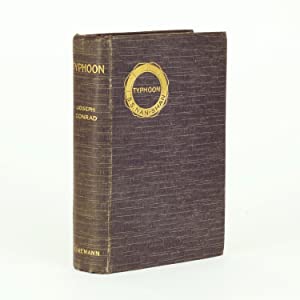
Typhoon and Other Stories is a collection of short fiction by Joseph Conrad published in 1903 by William Heinemann and Company.
















